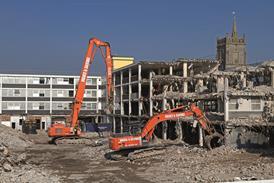If construction and warfare have anything in common, it’s that the top brass position themselves a safe distance from the people on the front line
Recently, as part of my job as a clerk of works, I was inspecting a replacement roof being constructed on a Victorian house. Renewing the timber structure of the roof were three carpenters. One of these was Rumanian, one was Lithuanian and one was from West Africa, but none spoke each other’s language or very good English. I had no idea how they could understand each other, or the foreman.
As I was climbing down the scaffolding, having failed completely to communicate with the carpenters, I found myself reflecting on the concept of friction expounded by Carl von Clausewitz, the 19th-century Prussian military strategist. (I know construction is not warfare but there are, I’m sure you’ll agree, many similarities: they both take place in a cut-throat environment, make extensive use of plans, and are highly labour-intensive.)
His premise was that friction takes place at the dichotomy between theory and practice, at the point where plans are turned into reality. To quote Clausewitz: “Everything in war is very simple, but the simplest thing is very difficult. Countless minor incidents, the kind you can never really foresee, combine to lower the general level of performance, so that one always falls far short of the intended goal. Each individual retains his potential for friction and the ability to delay things and make them go wrong.”
The three carpenters working on the roof seemed to me a classic example of this. But then, I reflected, the whole structure of the construction industry seems designed to create friction. As I have stated before in these columns, the industry is now divided into two parts. The major contractors and the large professional practices stand on one side as the superstructure while, on the other side, the small subcontractors and the workforce are the substructure. Very few of the major contractors employ anybody who actually carries out construction work; everything is subcontracted. The major contractors have pushed the responsibility for the risks involved and the carrying out of the work as far down the subcontracting ladder as possible.
At the point where the work is actually carried out, there is now a largely alienated workforce. Most workers are now self-employed (or bogusly self-employed) on a day-labour or price-work basis. For most of the skilled workforce there is no holiday pay, no sick pay, no pension and no job security. Nobody has a job for life and most are happy just to have a job at all. What have we got to offer high-calibre young people to motivate them to join the industry at the craft level? The truth is that the industry seems to have given up trying to attract new recruits and has settled for importing cheap labour from abroad instead.
I was involved with two large housing refurbishment contracts a few months ago, both involving about 80 houses. The main contractors in both cases directly employed three people on site; everybody else was subcontracted. We had great difficulty in achieving a good standard of painting on one of the contracts. The contract manager for the client said that he couldn’t understand this as the main contractor had been given a good price for the painting. But what he failed to consider was that beneath the main contractor were three layers of subcontractors to be waded through before the business of actually applying paint to windows could be addressed. The painters were all working on a price work basis. None that I spoke to even knew the name of the main contractor. There were others that I didn’t speak to, but only because they couldn’t speak English. However, I’m sure they were all acutely aware that they could be laid off for whatever reason with no notice whatsoever.
It is not rational for people in this situation to have any commitment to the job or the industry
It is not rational for people in this situation to have any kind of commitment to the job, the main contractors or the industry. Guy Glover the business director of Corus Tubes, a steel manufacturer, stated that he was not in business to make steel but to make money. This kind of attitude has been forced onto craft operatives. In the long run, the operative producing crap work at a quick rate will make more money than the craftsperson working with integrity and producing high-quality work. This is sad but true. Long-term structural pressures militate against producing good quality work.
It is possible to make plans, create programmes and organise jobs but if there is friction at the point of delivery then these will never work successfully. The superstructure seems to have washed its hands of the substructure and cast it adrift. The large professional firms can produce whatever plans or schemes they want, but until the gap between the two halves of the industry is reduced, this division will produce friction at the point where schemes become reality.
What happened to the three carpenters on the roof? Surprisingly, in the end they did a decent job.
John Smith is a clerk of works























No comments yet